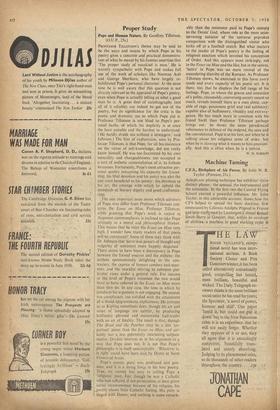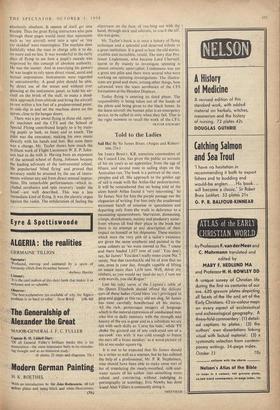Machine Taming
C.F.S., Birthplace of Air Power. By John W. R. Taylor. (Putnam, 21s.) AEROPLANE piloting technique has exhibitec' three distinct phases : the sensual, the instrumental and the automatic. fn the first two the Central Flying School exerted a powerful influence. Mr. John Taylor, in this admirable account, shoWs how the CFS helped to spread the basic doctrine, first enunciated by Celestin-Adolphe Pegoud in France and later reaffirmed by Lieutenant-Colonel Ro,bett Smith-Barry at Gosport, that, within its envelope of abilities,. a machine in good Working order is absolutely obedient. It cannot of itself get into trouble. Thus the great flying instructors who pass through these pages would insist that statements such as 'my aircraft went into a spin' or 'my car skidded' were meaningless. The machine does faithfully what the man in charge tells it to do, no more and no less. It was wonderful in the early days. of flying to see how. a pupil's morale was improved by this concept of absolute authority. He was the master. And in exercising his powers he was taught to rely upon direct visual, aural and tactual impressions. Instruments were regarded as untrustworthy. A. good pilot should be able, by direct use of the senses and without ever glancing at the instrument panel, to hold his air- craft on the brink of the stall; to make a dead- stick approach from altitude and bring the aircraft to rest within a few feet of a predetermined point; to side-slip in and set the machine down on the apron, close to the hangar doors.
There was a joy about flying in (hose old, open- air machines and the CFS and the School of Special Flying contributed largely to it by train- ing pupils to look, to listen and to touch. The pilot was the executant, making his own music directly with his hands and feet. But soon there was a change. Mr. Taylor shows how much the brilliant work of Flight Lieutenant W. E. P. John- son had to do with it. Having been an exponent of the sensual school of flying, Johnson became the leading advocate of the instrumental school. He popularised 'blind flying' and proved that accuracy could be attained by the use of instru- ments without any aid from direct sensual impres- sions. His remarkable performances—which in- cluded aerobatics and spin recovery 'under the hood'—are well described. This was a less immediate kind of flying. It was the electric organ against the violin. The exhilaration of feeling the slipstream on the face, of reaching out with the hand, through stick and ailerons, to touch the air; this was gone.
Mr. Taylor's book is at once a history of flying technique and a splendid and deserved tribute to a great institution. It is good to hear the old stories, credible and incredible, retold. The story that Pro- fessor Lindemann, who became Lord Cherwell, learnt to fly mainly to investigate spinning is almost certainly apocryphal. Lindemann was not a great test pilot and there were several who were working on spinning investigations. The illustra- tions are good and show, among other things, how advanced were the team aerobatics of the CFS formations at the Hendon Displays.
Today flying is entering its third phase. The responsibility is being taken out of the hands of the pilots and being given to the black boxes. In the latest aircraft the human pilot is an emergency device, to be called in only when they fail. That is the right moment to recall the work of the CFS.
OLIVER STEWART



















































 Previous page
Previous page